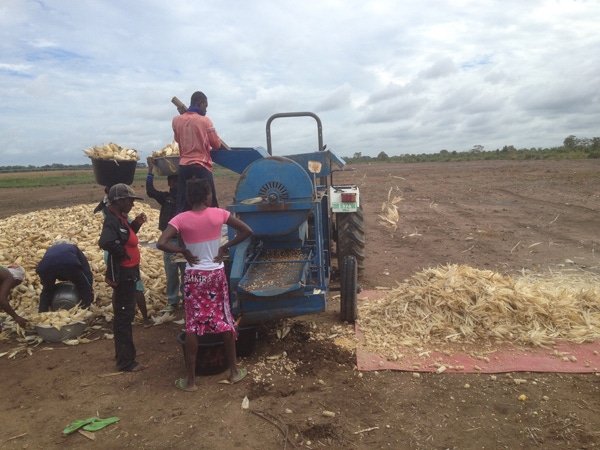October 1, 2012

Rain makes grain. This is something that almost every U.S. farmer hasn’t had enough of this year, and yields have suffered because of it. We, too, had that problem last year at our farm on the Afram Plains in Ghana, West Africa. We’d planted a 140-day maturity, No. 2 yellow corn Pioneer hybrid, which was produced in Brazil and imported into Ghana. I was confident the genetics were good, but due to the lack of rain/irrigation we ended up with a 27-bu./acre yield.
This was a wake-up call for me to get our irrigation system running. We had a 4-span Zimmatic system from the local dealer, but they had never actually sold or installed a system. Once I finally found an independent contractor with center-pivot experience in West Africa, our system was up in a week and was running for the crop we planted on April 22.
In our tropical climate, there are two rainy seasons in June and October when we receive the majority of our rain. We can get anywhere from 0.1 in. to more than 2 in. at a time. June provided good rains, but we relied heavily on our irrigation system for moisture in the other months. Our irrigation system was the best crop insurance we could find, since crop insurance is not available in Ghana.
The crop grew unlike anything I’d seen before. This year we were able to keep enough water on the crop, so we could observe exactly how a crop can grow under ideal conditions. (Kris talks about crop progress at http://bit.ly/P1Cwm7)
We receive 30-35 heat units/day. Our corn comes out of the ground in about four days, tassels at day 50 and has 24% moisture at day 120. This potentially allows for three crops a year if everything goes perfectly. While this is not likely, we will try to achieve 2.5 crops of corn per year.
We started harvest on Aug. 20,picking 40 acres by hand with about 25 women working each day. The local women filled pans of corn, which were carried to a barge wagon pulled by a tractor through the field. The corn was then dumped in piles where it was again picked up and carried to a sheller. After shelling it was put in bags until we accumulated enough shelled corn to fill our 800-bu. dryer.
We assembled our GT Manufacturing recirculating dryer on site. It runs on diesel fuel – perfect for a developing country. While LP is much more affordable, we have supply and handling problems.Ghana sometimes has supply shortages, and it's easier to convey diesel to the farm than 30-lb. LP cylinders.
After drying, we load the dry corn back into barge wagons where it is bagged from the wagons into 110-lb. bags.
We finished harvest on Sept. 12. It was a long, drawn out harvest with many processes but our 87-bu./acre corn yield is more than three times our dryland yield.
This is a better yield than my dad’s, who farms in central Illinois! After the challenges we’ve had, it is a great feeling to be able to make a difference in the developing world. Through the trials we’ve carried out with varieties, irrigation, and running a business in a developing country, we will be economically viable once our venture is at full scale.
Kristopher Klokkenga is a 32-year-old Illinois farmer who co-founded Africa Atlantic Franchise Farms in June 2010, where he’s managing director on Ghana’s Afram Plains. Africa Atlantic is a farm-management/farm-development company focused on production agriculture in Ghana.
About the Author(s)
You May Also Like




